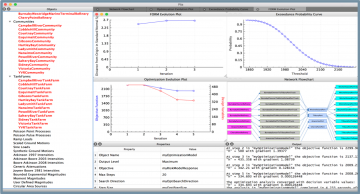Rt is the precursor for the computer program Rts, which we work on these days. The downloadable files posted below contains the final and stable Rt-release that will stand as a rock in the history of multi-model analysis software. Research work to extend and reshape Rt takes place at UBC in Vancouver under the leadership of Professor Haukaas and at Sharif University in Iran under the leadership of Professor Mahsuli. These branches are labelled Rts and Rtx, and you will find the former on this website.  As you can glance from the list of seminars elsewhere on this website the program Rt was conceived with funding from the “InRisk” infrastructure risk grant when Dr. Mahsuli commenced his PhD studies at UBC Vancouver. The motivation was rooted in the PEER triple integral for performance-based engineering, in which Professor Cornell split the problem into individual conditional probability models. While this became a productive tools for coordinating work in the PEER centre it is challenging to cast complex models for seismicity and building behaviour into the sought conditional probabilities. Rt was conceived to maintain the splitting of the problem into different models, but with greater flexibility in the analysis and uncertain modelling within each model. With Rt you can model the uncertain occurrence of earthquakes within a polygonal area source at the same time as you address the shaken building with a finite element model. This PhD work by Dr. Mahsuli is document in several journal papers, the first in this list being the official citation for Rt and the other two containing the description and application of some of the models in Rt:
As you can glance from the list of seminars elsewhere on this website the program Rt was conceived with funding from the “InRisk” infrastructure risk grant when Dr. Mahsuli commenced his PhD studies at UBC Vancouver. The motivation was rooted in the PEER triple integral for performance-based engineering, in which Professor Cornell split the problem into individual conditional probability models. While this became a productive tools for coordinating work in the PEER centre it is challenging to cast complex models for seismicity and building behaviour into the sought conditional probabilities. Rt was conceived to maintain the splitting of the problem into different models, but with greater flexibility in the analysis and uncertain modelling within each model. With Rt you can model the uncertain occurrence of earthquakes within a polygonal area source at the same time as you address the shaken building with a finite element model. This PhD work by Dr. Mahsuli is document in several journal papers, the first in this list being the official citation for Rt and the other two containing the description and application of some of the models in Rt:
- Mahsuli, M., and Haukaas, T. (2013). “Computer program for multimodel reliability and optimization analysis.” Journal of Computing in Civil Engineering, 27(1), pp. 87–98.
- Mahsuli, M., Haukaas, T. (2013) “Seismic risk analysis with reliability methods, Part I: Models.” Structural Safety, 42(1), pp. 54-62.
- Mahsuli, M., Haukaas, T. (2013) “Seismic risk analysis with reliability methods, Part II: Analysis.” Structural Safety, 42(1), pp. 63-74.
Rt is developed with C++ using the cross-platform development tool called Qt. For that reason Rt is available for on all three major platforms:
We no longer have YouTube tutorials available for future users of Rt although we may come up with such videos in the future. Instead you have here a Model Manual that provides an overview of the input and output to each model. A list of example input files are also provided below, together with the following description of how to use Rt: Once you have installed and started Rt you should store the first example, an explicit limit-state function, on your computer. Then drag & drop that file from the file explorer into Rt. This should create objects for random variables, limit-state function, and many other things; you will see them appear in the “objects pane” on the left side of Rt. Notice that the objects in that pane are divided into Models and Methods. Click on the Methods tab in the lower left corner to see the Methods, i.e., algorithms. The orchestrating algorithms, such as FORM and Sampling, are called Analyzers. To run a FORM analysis, click Analyses > Run Analysis on the menu bar at the top. The analysis will run once you click Ok in the dialog box that appears. Remember that you can create objects, both Models and Methods, in the user-interface of Rt or by loading an input file. Currently we have made available the following example input files:
-
- Explicit_LSF.txt
- Script_Modelling.txt + script.txt (please rename to “script.js”)
- Multiple_Models.txt + Building.txt
- Root_Finding_Model.txt
- St_Model.txt + Cantilevered_Beam.txt
- OpenSees_Frame_Model.txt + Frame.txt (please rename to “Frame.tcl” and get opensees.exe from elsewhere)